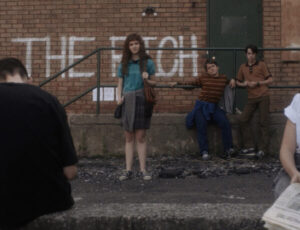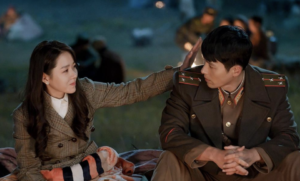Ushio Shinohara and Noriko Shinohara are the subjects of Zachary Heinzerling’s Cutie and the Boxer (2013). The film follows Ushio as he tries to revive his fading career with a show featuring his famed “boxing” paintings and other works. Ushio’s style of action painting had gained him some recognition in the art world during the 1960s. He’s giving his career one last kick before he decides to call it quits; he’s trying to forge a legacy. Meanwhile, Noriko is trying to shed her role as Ushio’s assistant and form her regain her identity as a creative artist through a series called Cutie and Bullie (a comic based on the chaotic forty-year marriage with Ushio).
For the entirety of the film, a sense of desperation commands the mood. Living in squalor in Brooklyn, the Shinohara’s finances are banking on the success of this next show to stay afloat. Yet, we learn that these are regular circumstances for these two, living as artists for their entire lives in America. They are the epitome of the stereotypical struggling artist. From this constant state of struggle comes intense honesty. We are given a window, not only into Ushio and Noriko’s marriage, but into the basics of human relationships: love, honesty, and constant hard work. Although this focuses more on Ushio’s art than Noriko’s, she is the true hero of the film. She is the stronger person of the two; a sage asian woman living with an 81-year old man-child artist. As the documentary progress we learn more about her hardships as a young mother with an alcoholic husband and her difficulty to assert herself as an artist separate from her husband ?— an already well-respected figure in the art community. The art takes second priority to their relationship as the subject of the film. There are a lot of layers and subtleties to Ushio and Noriko’s relationship. It’s symbiotic. They both need each other for different reasons. Noriko is the pillar and has been raising both her son and Ushio (often referred to as “a child” by Noriko during the film) since she moved to New York as a 19-year old. She supports her husband’s work and lifestyle, but as an artist herself is forced to deal with the pain of her own creative expression taking a backseat while Ushio’s art becomes the priority. Noriko is a strong, stoic woman and essential to Ushio’s creative process. Without her, Ushio would fall to pieces. On the flip side, Ushio serves as a major inspiration for Noriko. She admires his work and, on top of calling him a child, refers to him as a genius. Which serves as a testament to the thought that artists are children at heart. Her love for Ushio is limitless. She’s willing to sacrifice her own passion for the small chance that he will acquire the fame he desires. She’s chained by her love for this older man, but sees no other option. It’s not a choice to be with Ushio; in her eyes, there’s no other way. Heinzerling puts the film together in a way that lacks sympathy. This isn’t a movie made for the viewer to weep over the struggles of these two artists. This is simply a portrait of a strange relationship that has flourished in unusual circumstances between an unlikely couple. Scenes of somber reality are interrupted by cute, candid moments between the couple that reminds the viewer that these two will never truly be miserable. Regardless of their financial status, as long as they are together, they will be happy.







